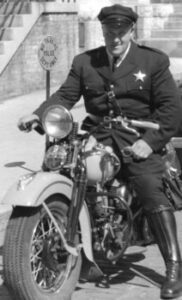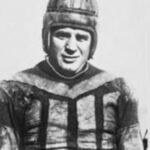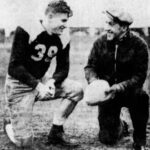Long before we could watch football games on our phones, or talk with our friends using our wristwatch, there was Dick Tracy. On this episode of “When Football Was Football,” we’ll visit the original Dick Tracy, a crime-fighting cartoon character whose fame achieved worldwide status thanks to a rather large former lineman from the Chicago Cardinals.
We’ll also visit with an enormously successful punt returner for the Cardinals whose brief career, and small stature, in the NFL has been largely forgotten, but whose story remains an inspiration.
When you encounter an NFL player named “Tiny,” your expectations for the story behind that nickname intensify. Was he a big man, or rather a smaller player? Sometimes, nicknames can often go both ways…
Enter Emery “Tiny” Hansman, a man of generous proportions, often reaching 400 pounds during his lifetime. He was also an immense tackle who joined the Chicago Cardinals without the benefit of playing in college, resulting in his being a starter in 1936 in a game when the Cards scored the most points in team history.
Who Is Dick Tracy?
Although Tiny’s tenure with the Cardinals was brief, he achieved lifelong notoriety due to both his appetite as well as for his celebrated partnership with Dick Tracy. And who is Dick Tracy, you might ask?
Back in 1931, cartoonist Chester Gould of Woodstock, IL, created the newspaper cartoon character Dick Tracy, a no-nonsense, square-jawed, police detective who focused his efforts on fighting crime and knocking surly criminals out of action. Somewhat like a defensive lineman pursuing an opposing quarterback!
Through Chester Gould, Dick Tracy took advantage of futuristic crime-fighting tools, such as a two-way wrist radio, and later, a two-way wrist television. As you know, many of these imagined high-tech accessories from then have actually found their way into reality in the ensuing years.

Gould continued the cartoon strip until his retirement in 1977, and various artists have continued working on the “Dick Tracy” product since that time. For 46 years, Gould created the multitude of Dick Tracy episodes from his office in Woodstock, IL, which is perhaps better known for being the key filming site of the 1993 movie “Groundhog Day.”
Known As Tiny Because of His Physique
And, Woodstock was also the home of a gentle giant named Emery “Tiny” Hansman, a gigantic football player who would eventually become the police chief of Woodstock. In 1963, the Chicago Tribune covered the retirement of Hansman from the Woodstock police force:
“Hansman, highly regarded in Woodstock for his work as chief, is known by everyone in the town as ‘Tiny” because of his 250-pound physique distributed over a broad six-foot, two-inch frame. He weighed nearly 370 pounds at one time.”

But before he became police chief, Hansman’s main ambition in life was to play football. He was a steady lineman for the Woodstock High School football team as a youth before graduating in 1931, winning three letters on the varsity (heavyweight) team, while also starring in basketball and track.
The Daily Sentinel in Woodstock described Tiny’s gridiron expertise: “He played both the line and in the backfield during his high school days, helped his team at all times in advancement with the art of football playing.” Most locals assumed he would move comfortably right on to college and play for the university of his choice.
Instead, Tiny chose to seek employment locally but still remained involved in football, suiting up for the local Woodstock Townsend Chevies in 1932 and then for several seasons with the Harvard Legion football club. Tiny fit right in with the Harvard club, which relied on a very large and overpowering front line as humorously noted by the Daily Sentinel: “The Harvard Legion eleven, a team that was composed of so much weight that the popular belief was that freight trains carried the players around on traveling games!”
Then, in 1936, Hansman received the opportunity to play for the Chicago Cardinals of the National Football League. During his brief time with the team, Tiny found his name in the newspapers both for his football skills as well as for his eating habits. In 1936, the Cardinals held their pre-season training camp in Michigan City, IN, and Tiny was invited to join in the gridiron festivities.
Having Lots of Fun and Losing Weight!
This was big news back in Woodstock and the local media retained a sharp eye on the progress of Tiny at the Cardinals’ camp. Even a letter that Tiny wrote to his mother from training camp was quoted in the Woodstock news: “Am having a lot of fun and losing weight. Might make the team but nothing is for sure yet.”
As training camp progressed under Coach Milan Creighton, the Chicago Tribune reported that Hansman would be the starting left tackle for the Cardinals in the opening exhibition contest against the South Bend Kamm Brewers in Michigan City, IN. On August 30, 1936, with Tiny boosting the front line, the Cardinals romped to an easy 70-0 win, still the most points ever scored by the Cards in one game.
The Tribune noted the strong game played by Hansman: “Tiny Hansman and Bert Pearson were outstanding for the Cardinals on defense, breaking up the South Bend scoring attempts time and again.”
Although not a starter, Hansman experienced ample time on the field in the next exhibition game, a 10-7 loss to the Green Bay Packers on September 13, 1936. The Cardinals stayed north for the third pre-season contest on September 20 in a match with the La Crosse (WI) Lagers. Prior to the game, the La Crosse Tribune put the spotlight on several of the Cardinals players, including Tiny: “They call Hansman Tiny because he isn’t. In fact, he’s the biggest person in the national league.
He weighs 260 pounds and the most surprising thing of all is that he can run. Gets down under punts as fast as ends, and his defensive ability makes him a valuable tackle on any squad. Never played college football, but has shown enough knowledge and ability to get a chance in the pro league.”
Tiny Got Away With Eight Frankfurters!
The Cardinals and Coach Creighton were treated royally during their time in La Crosse, including being taken on a tour of the area, appearing on radio shows, and visiting local schools. One of the highlights, according to the La Crosse Tribune, was a cook-out on a bluff near town: “They went to Grandad Bluff where Bill Bonadurer had prepared a wiener roast. Manager Art Wolfs said later that Tiny Hansman, 260-pound lineman, got away with eight frankfurters!”
During the Cards 20-0 win over the Lagers, Tiny enjoyed considerable playing time and still hoped to make the final roster, but those hopes were dashed with he was one of the final cuts made by the team on September 24. The Daily Sentinel reported the sad news to its readers in Woodstock: “We learned with regret that Tiny Hansman has been released by the Chicago Cardinals. However, he is grateful for the fine support given him by local people on behalf of his candidacy for a berth on the Cardinal squad.”
With his professional football career over, Tiny returned to Woodstock, served in World War II as a sergeant in the Air Corps, and joined the Woodstock Police Department, serving 22 years with 14 of those as Chief.
And this is where the connection between Tiny Hansman and Dick Tracy began—both legends and both created in Woodstock, IL! Tiny was famous for his work with the younger generation in Woodstock and once said:
“I’ve always believed that if policemen will work with kids as they grow up and let them know we are their friends, they will cause no problems as teenagers, and adults.”
Tiny Provided Sound Advice On Dick Tracy
Tiny also worked closely with his friend, Chester Gould, to create the Dick Tracy Crime Stoppers program for young adults. George Meyers of Woodstock shared this story in 1989 with the Northwest Herald newspaper in Woodstock: ”Tiny and Gould discussed facets of police work, and Tiny provided Chet with sound advice on helping Dick Tracy portray police work accurately. Tiny and Chet realized youngsters did not have enough direction or inspiration.”
The result was the formation of Dick Tracy’s Crime Stoppers in 1947, an honorary junior law enforcement club designed to help kids follow the right path in life. Initially, it was just a local organization in Woodstock where Tiny would meet with the young members on a Saturday morning at the Woodstock Opera House. The Dick Tracy Museum once wrote
“Meetings were filled with fun, interspersed with safety films and talks on safety prevention. Once in a while, a member of the FBI or the state police spoke on the importance of safety. Even Chester Gould did his part.” Kids could also earn an official Crime Stopper badge. George Meyers recalled: “It was a prestigious thing to have a Crime Stopper badge. It showed you were a good kid. Not to have one—well, some might think you weren’t so good.” In addition, Gould used Tiny as the inspiration for his “Crime Stopper Cop” character in the Dick Tracy series.
Soon, several hundred kids were attending the Saturday programs in Woodstock, which were usually led by the friendly Tiny Hansman. Quickly, the program spread across the United States, thanks to a mention by Chester Gould on the Edward R. Murrow television show, and eventually internationally as well with thousands of participating organizations around the world.
Upon Hansman’s retirement from the police force in 1963, Woodstock Mayor Thor Emricson said: “Tiny is as dependable as he is large.” Tiny passed away in June of 1981 at the age of 68. Dick Tracy creator Chester Gould mourned his old friend and stated: “It was one of the best things that happened to Woodstock when Tiny Hansman became police chief. Tiny was very sensitive about training youngsters and he held Crime Stopper meetings for them to curb vandalism in town.” From the Cardinals to the cartoons, Tiny Hansman has remained a larger-than-life figure.
Goble Brought Back Kick 94 Yards
Next, we’ll visit a former Cardinal with excessive speed, great hands, and a knack for returning kickoffs for scores. In his very first game with the Cardinals on September 26, 1954, Les Goble brought back a kick from 94 yards out for a touchdown against the New York Giants. Later, in the same game, he returned another kickoff 55 yards. After that, the Giants were hesitant to kick in his direction. “That ticked me off,” Goble told the Morning Times.
If that wasn’t enough, in his second game ever, this time against the Eagles on October 3, 1954, Goble repeated that effort with a 92-yard scoring return on the opening kickoff! The Philadelphia Inquirer reported: “The Eagles were knocked on their heels on the opening kickoff when Les Goble, a 160-pound halfback from little Alfred (NY) University, returned Chuck Bendarik’s boot 92 yards for a touchdown.
It was such a stunner that nary an Eagle got their hands on him and not a single Chicago block was needed. Goble, who ran back a kickoff 94 yards last week in the opener against the Giants, merely bolted between two onrushing Eagles into the clear at the 30, and no one came close to touching him.”

That Ticked Me Off!
Regarding the Eagles game, Goble recalled that effort: “They kicked to the rookie and I took it all the way back. They refused to kick it to me again. And that ticked me off!”
With those three early kick returns paving the way, Goble led the NFL in 1954 in kickoff return yard average with a 27.7 mark per return; was second in the league in total kickoff return yardage with 749; and was third in combined kickoff and punt return yards with 800. Not bad for a rather frail 160-pounder who proved that a small man from a small college could make a big name for himself in the National Football League!
Goble’s athletic career began in his hometown of Waverly, New York where he was a spectacular sprinter on the high school track team and an evasive runner on the gridiron. The Star-Gazette noted that “Goble was an end at Waverly as a sophomore but switched to halfback for his last two years. He tried track in his senior year when Waverly invaded that sport and had a 9.9 clocking for 100 yards.”
That talent and speed led Goble to Alfred University from 1951-1954 where he was a dominant sprinter and an electrifying halfback, and was eventually included in the school’s Sports Hall of Fame. The Star-Gazette summarized Goble’s outstanding collegiate career prior to his induction in 1973: “Goble, a halfback grid star, was named Little All-American. He was also Eastern Intercollegiate 220 yard-low hurdles champ at Alfred.”
During his senior season at Alfred, Goble paced the team to a 5-1 record, scoring 49 points and rushing for 700 net yards, good for tenth in the country. Against Rensselaer Polytechnic University, Goble scored three times in a 55-7 romp; added two more touchdowns in a 41-6 win over Ithaca; and then scored one rushing TD and passed for another in a 47-0 shutout over the University of Buffalo.
After the season, Goble was selected to the second team of the Little All-American squad, composed of players from smaller colleges and universities. This achievement caught the interest of the Cardinals, who signed Goble to a rookie contract.
Goble Is Outstanding, Weighing Only 154 Pounds
Of course, his phenomenal performance on returns as well as his rushing ability prompted the Cardinals to re-sign Goble on April 30, 1955. However, his playing time was limited due to injuries and also by sharing return duties with future Pro Football Hall of Famer Ollie Matson.
Despite the drop-off in production due to the injuries, the Cards signed Goble to his third contract on May 22, 1956. The Arlington Heights Herald announced the signing a bit later, praising the success of Goble despite his size: “Goble is one of the outstanding backs in the National Football League on kickoff and punt returns, standing 5-11 and weighing only 154 pounds.
Last year, Goble was used primarily on defense, and due to injuries [he fractured his hand against Pittsburgh in the seventh game], he only returned eight kickoffs for 160 yards. Les can run the 100 in 9.8 seconds.”
Unfortunately, Goble did not appear in any regular season games with the Cardinals in 1956 after being released in training camp. He signed with the Hamilton Tiger-Cats of the Canadian league on May 14, 1957, and the team explained the reason behind his availability to the Hamilton Spectator: “He specialized on defense but lost his chance to play regularly in spite of being the third-highest Card scorer during the 1955 season, because of injury.”
With his professional playing career over, Goble returned home to Waverly, New York, did some semi-pro football coaching, and eventually was the owner of several businesses for many years.
It should be noted that after all of these years, Goble remains among the all-time Cardinals’ leaders in kickoff return action, is third for most return TDs in a season, and is believed to be the leader in return average for a single game after he posted a 46.3 average on September 26, 1954, in that game against the Giants. Goble passed away on December 2, 2019, at the age of 87.
Thank you for joining us here on the Sports History Network for this episode of “When Football Was Football.” We hope you enjoyed the interesting stories behind two Cardinals you may not have known about: an overly large man who specialized in knocking opponents down, while the other was an inspiring lightweight who specialized in avoiding being knocked down!
Watch for a new episode coming soon where we’ll look back on the 75th anniversary of what we consider the Cardinals’ greatest season—1948!
Author and Host - Joe Ziemba
Joe Ziemba is the host of this show, and he is an author of early football history in the city of Chicago. Here, you can learn more about Joe and When Football Was Football, including all of the episodes of the podcast.

Please Note – As an Amazon Associate I earn from qualifying purchases
Resources
More From When Football Was Football
Paddy Driscoll’s Almost Perfect Season
Back at the beginning of the National Football League in...
Read More120,000 Fans Witness High School Football Game in 1937!!!
Let’s set the stage… It was a warm November afternoon...
Read MoreIn The Beginning: An Interview With Joseph T. Sternaman
And, you may ask, who is Joseph T. Sternaman? Sternaman...
Read More1948: The Last Hurrah of the Chicago Cardinals
Cardinals’ fans are familiar with the long, sad story concerning...
Read More


